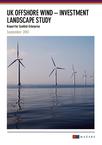UK offshore wind - Investment Report
About usNews, publications and mediaOur publicationsSurveys and studies
UK offshore wind - Investment Report
In June 2013, Scottish Enterprise commissioned Mazars to produce a report on the offshore wind investment landscape in the UK. The principal aim of the study was to identify the funding requirements of the UK’s offshore wind farm projects and the potential means to meet these requirements.
We concluded our report in September 2013, based on analysis conducted in July 2013, with key findings as follows:
- Offshore wind is an increasingly important part of the UK energy mix, with a huge pipeline of projects. This pipeline would imply new private sector investment of well over £100 billion, and would bring important benefits to the UK in terms of increasing security of supply, reducing carbon emissions and creating jobs.
- However, the timely roll-out of this project pipeline is not guaranteed, as:
- it is dependent on positive private sector investment decisions: the balance of risks and returns will need to stack up for each individual project and there is significant competition for capital between sectors and markets;
- public subsidies are reducing and will be insufficient to support many projects currently under development unless there are dramatic reductions in cost. But this will require policy clarity and long-term commitment to the sector to 2030; and
- it is constrained by the amount of private sector funding available: a function of the size of sponsors’ balance sheets, the availability of project debt and the ability of sponsors to recycle capital once projects are operational.
- New sources of capital will need to be found if projects currently under development are to proceed. We estimate that there is a current annual funding capacity of approximately £7.5 billion, comprising a mix of equity from current project sponsors and debt from currently active commercial lenders and multilateral lending agencies. This will need to be augmented from 2015 onwards: 12 out of the 16 projects capable of reaching final investment decisions within the next two years are likely to require capital from sources other than the current project sponsors.
- These projects, together with ongoing potential to acquire stakes in operational projects, amount to a significant opportunity for new investors to come into the sector. Although still dominated by utilities, the European offshore wind sector is already starting to see the emergence of other categories of investors, including pension funds, infrastructure funds, private equity funds, supply chain participants and corporates.
- For there to be a step-change in outside investment though, a number of things will need to happen, many of them inter-linked. These include reduced construction costs (which will also allow more projects to be granted Contracts for Difference within the budgetary constraints of the Levy Control Framework), reduced operational risks, a strengthening project finance market and the emergence of better-capitalised supply chain participants.

